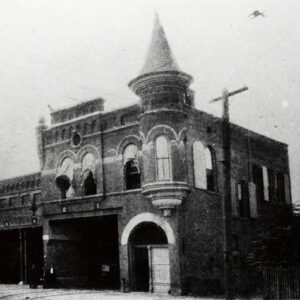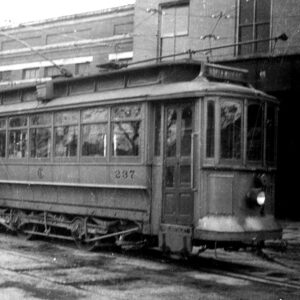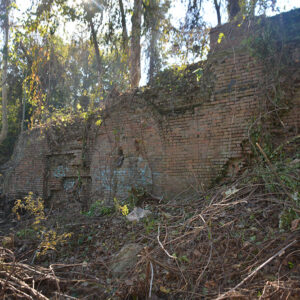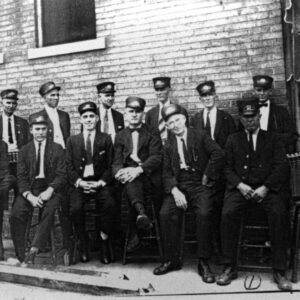calsfoundation@cals.org
Little Rock Railway & Electric Company (LRREC)
The Little Rock Railway & Electric Company (LRREC) played a key role in the electrification, modernization, and continued operation of the intra-urban streetcar transportation system that served the citizens of Little Rock (Pulaski County) in the late nineteenth and early twentieth centuries.
Prior to electrification, the intra-urban streetcar system in Little Rock consisted of animal-drawn conveyances along the first rail lines built in 1877 by the Citizens’ Street Railway Company by businessmen from Little Rock and Hot Springs (Garland County). Over the next decade, technological developments, including the electric lamp (streetlight), more efficient power generation/distribution, and trolley pole systems allowed animal-drawn streetcars to be gradually replaced with electric streetcars. Early on, several streetcar companies—such as Capital City Street Railway Company, City Electric Street Railway Company, and Little Rock Street Railway—competed for the right to plan routes, run track, and electrify existing routes. From the beginning, the location of streetcar lines served business ventures, influenced the development of suburbs like Pulaski Heights and connected citizens to recreation areas like West End Park. However, the ability to manufacture and distribute electricity through transportation and its associated infrastructure was crucial in making the enterprise sustainable.
Little Rock native Horace G. Allis consolidated several competing companies (City Electric, Citizens’ Street Railway, and Little Rock Street Railway) into the Capital Street Railway Company. Also serving as president of the Consumers Power and Light Company, Allis oversaw the construction of an integrated streetcar barn and power-generating station along the south bank of the Arkansas River at 1100 North Street, which was an important step in the establishment of a city-wide electric streetcar system.
Despite efforts to keep control in local hands, financial mismanagement by Allis, who was also president of the First National Bank of Little Rock, coupled with the effects of the Panic of 1893, resulted in the company’s sale. Under circumstances outlined in headlines of the Arkansas Gazette, it was not until substantial financial investment and new technological expertise came from outside Arkansas that the enterprise stabilized. In 1902, led by New York–based railway tycoon Hart D. Newman, I. Newman & Sons obtained the Little Rock Traction & Electric Company (LRTEC) and the Little Rock Edison Light and Power Company, forming the Little Rock Railway & Electric Company (LRREC).
Under the LRREC’s new management and its utilization of services by the New York–based engineering firm Ford, Beacon, & Davis, $500,000 was committed for rail improvements, service expansions, and streetcar upgrades. By February 1904, a new line to Pulaski Heights was in operation; new trolley barns and power stations were constructed at Water, Arch, and Gaines streets; and the old trolley barn at North Street was decommissioned and turned into company offices. The following year, Newman and Sons began acquiring a number of other railway companies based in several southern cities such as Little Rock, Memphis, Birmingham, and Nashville, under the Newman Properties Association (NPA).
Despite acquiring transportation companies/systems in other southern cities, NPA and by extension the LRREC were not singly focused on business acquisition and profits but instead were equally invested in the communities in which they operated. As noted by the Arkansas Gazette in 1908, “no plan of civic growth and greatness can be conceived without the electric railroad.” To that end, for two decades, the activities of the LRREC were instrumental to the further development of the city. The company continued to operate until 1923, when it was acquired by the Arkansas Power and Light Company (AP&L). With the increased demand for personal, motorized vehicle transportation, the last electric streetcar associated with LRREC ceased running in 1947.
For additional information:
Chovanec, Zuzana, and Timothy S. Dodson. “The Early History of Streetcar Transportation in Little Rock, Arkansas, 1870–1948.” Arkansas Review: A Journal of Delta Studies 54 (April 2023): 44–58.
Hempstead, Fay. “Daniel A. Hegarty.” In Historical Review of Arkansas: Its Commerce, Industry and Modern Affairs. Chicago: Lewis Publishing Company, 1911, pp. 844–845.
Olsson, Carl. “Mule Car to Bus: R. A. Koonce Records History of Little Rock’s Street Transportation System.” Arkansas Democrat Sunday Magazine, August 21, 1938, p. 3.
Patty, William J. “The Great Civic Improvement: The Journey Towards Electric Traction in Little Rock.” Pulaski County Historical Review 51 (Spring 2003): 2–16.
Timothy S. Dodson
Nashville, Tennessee
Zuzana Chovanec
Jacksonville, Florida
 Early Twentieth Century, 1901 through 1940
Early Twentieth Century, 1901 through 1940 Transportation
Transportation Car Barns
Car Barns  Citizen's Railway Company
Citizen's Railway Company  Little Rock Streetcar
Little Rock Streetcar  Little Rock Streetcar Barn Remnants
Little Rock Streetcar Barn Remnants  Streetcar Conductors
Streetcar Conductors 




On December 12, 1917, one of the street cars hit my father. He was 10 years old, and he suffered severe head injuries. He was walking with his mother, Mary Champion, in Little Rock.